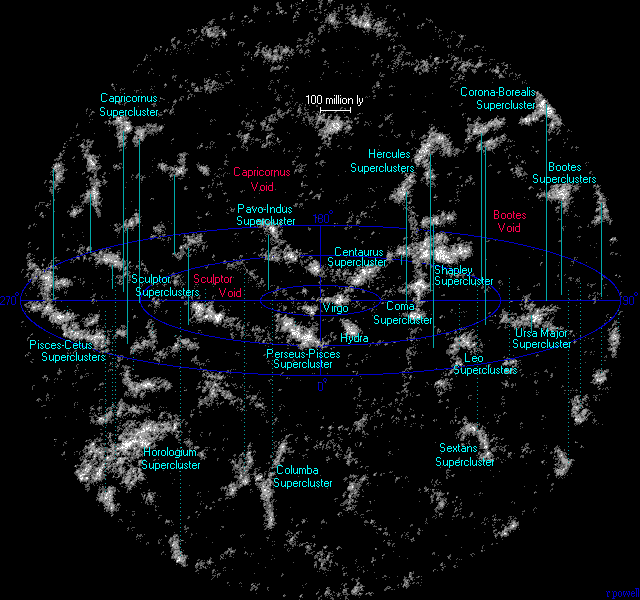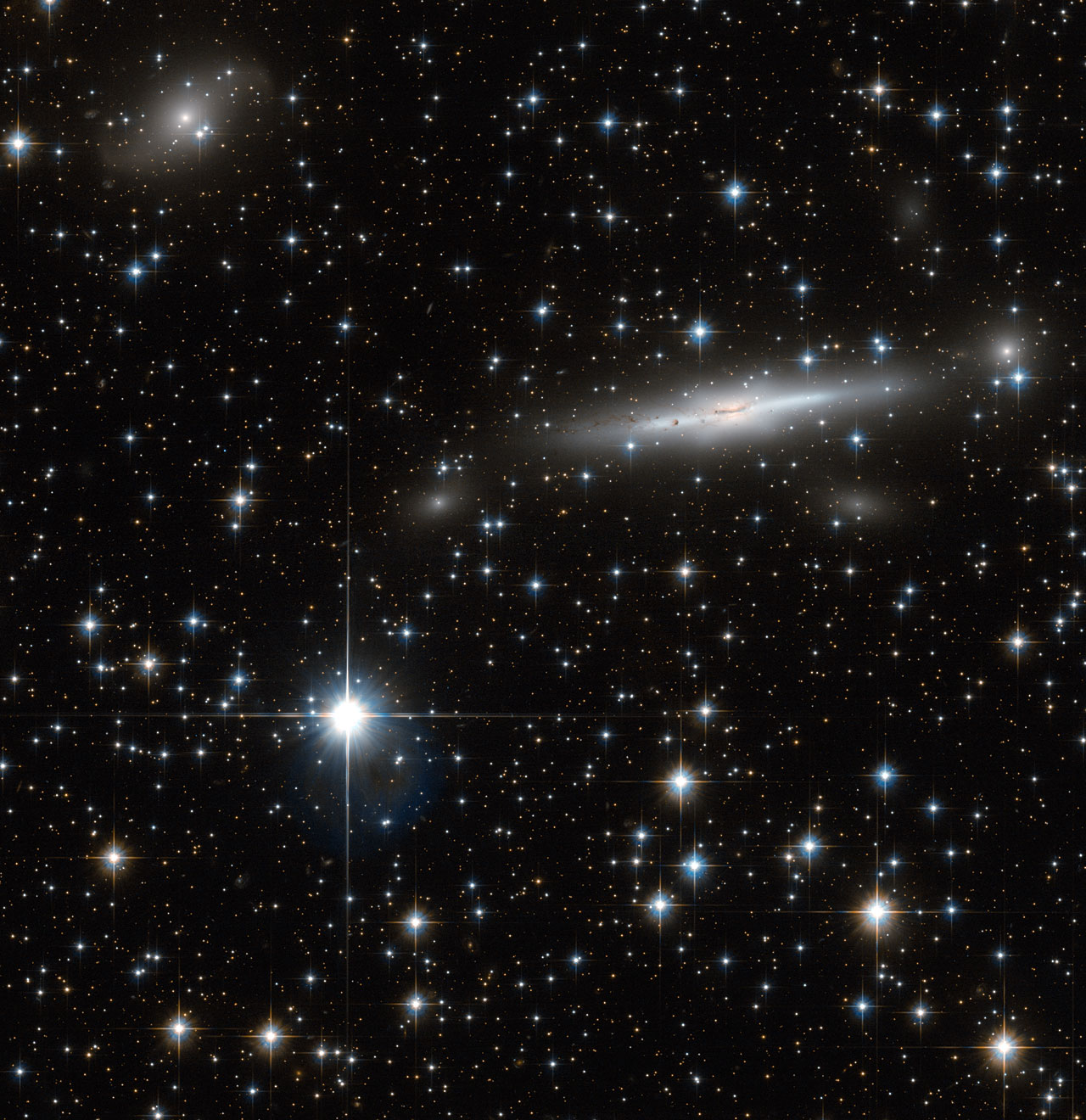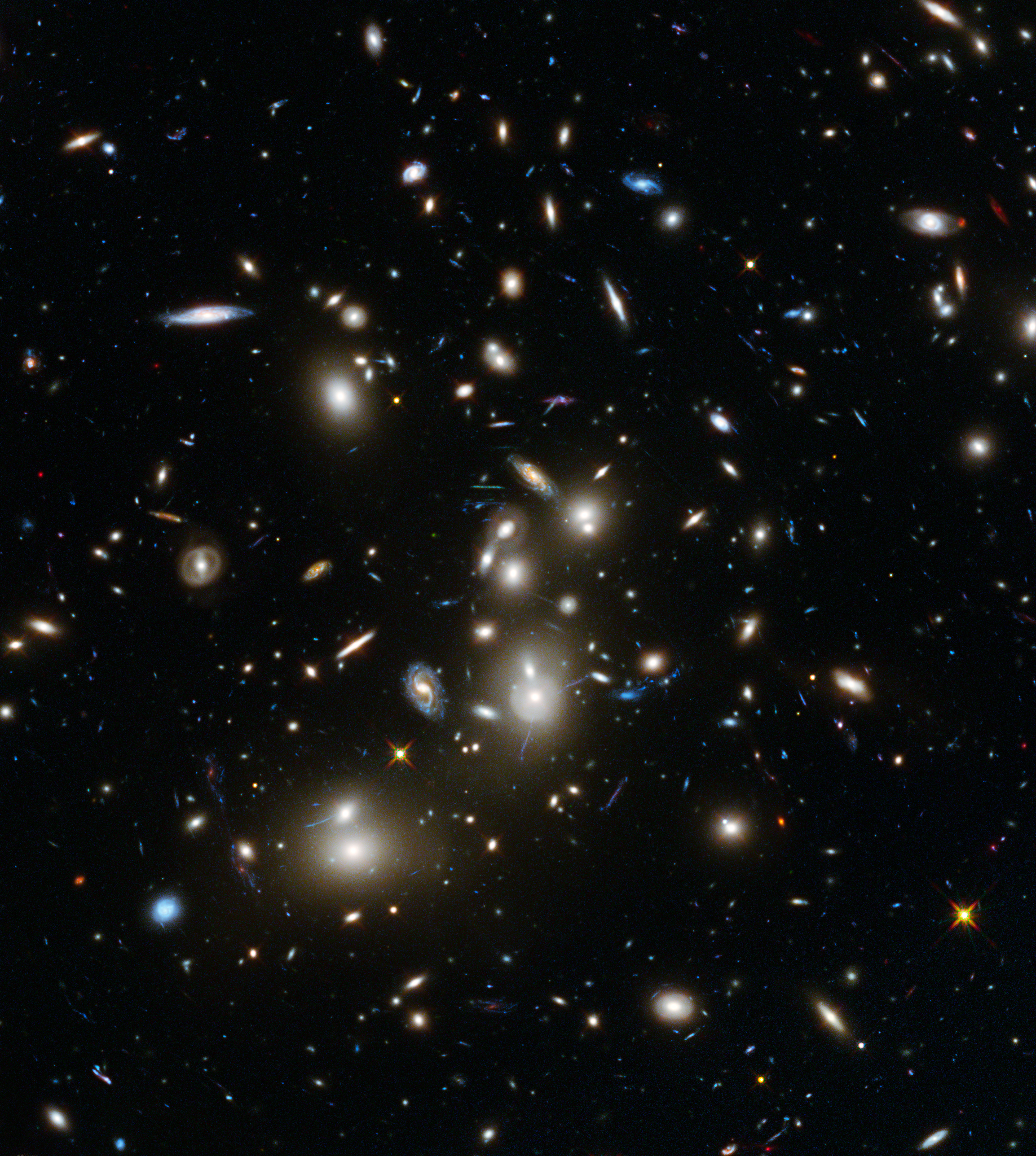|
Shapley Supercluster
The Shapley Supercluster or Shapley Concentration (SCl 124) is the largest concentration of galaxies in our nearby universe that forms a gravitationally interacting unit, thereby pulling itself together instead of expanding with the universe. It appears as a striking overdensity in the distribution of galaxies in the constellation of Centaurus. It is 650 million light-years away (redshift, z=0.046). History In 1930, Harlow Shapley and his colleagues at the Harvard College Observatory started a survey of galaxies in the southern sky, using photographic plates obtained at the 24-inch Boyden Observatory#Former telescopes, Bruce telescope at Bloemfontein, South Africa. By 1932, Shapley reported the discovery of 76,000 galaxies brighter than 18th apparent magnitude in a third of the southern sky, based on galaxy counts from his plates. Some of this data was later published as part of the Harvard galaxy counts, intended to map galactic obscuration and to find the space density of galax ... [...More Info...] [...Related Items...] OR: [Wikipedia] [Google] [Baidu] |
Supercluster
A supercluster is a large group of smaller galaxy clusters or galaxy groups; they are among the largest known structures in the universe. The Milky Way is part of the Local Group galaxy group (which contains more than 54 galaxies), which in turn is part of the Virgo Supercluster, which is part of the Laniakea Supercluster."Earth's new address: 'Solar System, Milky Way, Laniakea ''Nature (journal), Nature'' The large size and low density of superclusters means that they, unlike clusters, expand with the Hubble expansion. The number of superclusters in the observable universe is estimated to be 10 million. Existence [...More Info...] [...Related Items...] OR: [Wikipedia] [Google] [Baidu] |
Virgo Cluster
The Virgo Cluster is a large cluster of galaxies whose center is 53.8 ± 0.3 Mly (16.5 ± 0.1 Mpc) away in the constellation Virgo. Comprising approximately 1,300 (and possibly up to 2,000) member galaxies, the cluster forms the heart of the larger Virgo Supercluster, of which the Local Group (containing our Milky Way galaxy) is a member. The Local Group actually experiences the mass of the Virgo Supercluster as the Virgocentric flow. It is estimated that the Virgo Cluster's mass is 1.2 out to 8 degrees of the cluster's center or a radius of about 2.2 Mpc. Many of the brighter galaxies in this cluster, including the giant elliptical galaxy Messier 87, were discovered in the late 1770s and early 1780s and subsequently included in Charles Messier's catalogue of non-cometary fuzzy objects. Described by Messier as nebulae without stars, their true nature was not recognized until the 1920s. The cluster subtends a maximum arc of approximately 8 degrees centered in the constellation ... [...More Info...] [...Related Items...] OR: [Wikipedia] [Google] [Baidu] |
Shapley Attractor
The Shapley attractor is an attractor located about the Shapley Supercluster. It is opposed to the Dipole Repeller, in the CMB dipole of local galactic flow. It is thought to be the composite contributions of the Shapley Concentration and the Great Attractor The Great Attractor is a gravitational anomaly in intergalactic space and the apparent central gravitational point of the Laniakea Supercluster. The observed anomalies suggest a localized concentration of mass millions of times more massive than .... References Shapley Supercluster {{physical-cosmology-stub ... [...More Info...] [...Related Items...] OR: [Wikipedia] [Google] [Baidu] |
Milky Way
The Milky Way is the galaxy that includes our Solar System, with the name describing the galaxy's appearance from Earth: a hazy band of light seen in the night sky formed from stars that cannot be individually distinguished by the naked eye. The term ''Milky Way'' is a translation of the Latin ', from the Greek ('), meaning "milky circle". From Earth, the Milky Way appears as a band because its disk-shaped structure is viewed from within. Galileo Galilei first resolved the band of light into individual stars with his telescope in 1610. Until the early 1920s, most astronomers thought that the Milky Way contained all the stars in the Universe. Following the 1920 Great Debate between the astronomers Harlow Shapley and Heber Curtis, observations by Edwin Hubble showed that the Milky Way is just one of many galaxies. The Milky Way is a barred spiral galaxy with an estimated D25 isophotal diameter of , but only about 1,000 light years thick at the spiral arms (more at the bulg ... [...More Info...] [...Related Items...] OR: [Wikipedia] [Google] [Baidu] |
Great Attractor
The Great Attractor is a gravitational anomaly in intergalactic space and the apparent central gravitational point of the Laniakea Supercluster. The observed anomalies suggest a localized concentration of mass millions of times more massive than the Milky Way. However, it is inconveniently obscured by our own Milky Way's galactic plane, lying behind the Zone of Avoidance (ZOA), so that in visible light wavelengths, the Great Attractor is difficult to observe directly. In fact, it will not be for another hundred million years that Earth will be on the other side of the Milky Way galaxy, allowing us to see past the galactic plane. The anomaly is observable by its effect on the motion of galaxies and their associated clusters over a region of hundreds of millions of light-years across the universe. These galaxies are observable above and below the ZOA; all are redshifted in accordance with the Hubble flow, indicating that they are receding relative to us and to each other, but the v ... [...More Info...] [...Related Items...] OR: [Wikipedia] [Google] [Baidu] |
Peculiar Motion
Peculiar motion or peculiar velocity refers to the velocity of an object relative to a ''rest frame'' — usually a frame in which the average velocity of some objects is zero. Galactic astronomy In galactic astronomy, peculiar motion refers to the motion of an object (usually a star) relative to a Galactic rest frame. Local objects are commonly examined as to their vectors of position angle and radial velocity. These can be combined through vector addition to state the object's motion relative to the Sun. Velocities for local objects are sometimes reported with respect to the local standard of rest (LSR) – the average local motion of material in the galaxy – instead of the Sun's rest frame. Translating between the LSR and heliocentric rest frames requires the calculation of the Sun's peculiar velocity in the LSR. Cosmology In physical cosmology, peculiar velocity refers to the components of a galaxy's velocity that deviate from the Hubble flow. According to ... [...More Info...] [...Related Items...] OR: [Wikipedia] [Google] [Baidu] |
Cosmic Microwave Background
In Big Bang cosmology the cosmic microwave background (CMB, CMBR) is electromagnetic radiation that is a remnant from an early stage of the universe, also known as "relic radiation". The CMB is faint cosmic background radiation filling all space. It is an important source of data on the early universe because it is the oldest electromagnetic radiation in the universe, dating to the epoch of recombination when the first atoms were formed. With a traditional optical telescope, the space between stars and galaxies (the background) is completely dark (see: Olbers' paradox). However, a sufficiently sensitive radio telescope shows a faint background brightness, or glow, almost uniform, that is not associated with any star, galaxy, or other object. This glow is strongest in the microwave region of the radio spectrum. The accidental discovery of the CMB in 1965 by American radio astronomers Arno Penzias and Robert Wilson was the culmination of work initiated in the 1940s, and earned th ... [...More Info...] [...Related Items...] OR: [Wikipedia] [Google] [Baidu] |
Local Group
The Local Group is the galaxy group that includes the Milky Way. It has a total diameter of roughly , and a total mass of the order of . It consists of two collections of galaxies in a "dumbbell" shape: the Milky Way and its satellites form one lobe, and the Andromeda Galaxy and its satellites constitute the other. The two collections are separated by about and are moving toward one another with a velocity of . The group itself is a part of the larger Virgo Supercluster, which may be a part of the Laniakea Supercluster. The exact number of galaxies in the Local Group is unknown as some are occluded by the Milky Way; however, at least 80 members are known, most of which are dwarf galaxies. The two largest members, the Andromeda Galaxy and the Milky Way, are both spiral galaxies with masses of about solar masses each. Each has its own system of satellite galaxies: * The Andromeda Galaxy's satellite system consists of Messier 32 (M32), Messier 110 (M110), NGC 147, NGC 185, A ... [...More Info...] [...Related Items...] OR: [Wikipedia] [Google] [Baidu] |
Shapley
Shapley is a surname that might refer to one of the following: * Lieutenant General Alan Shapley (1903–1973), of the U.S. Marine Corps, was a survivor the sinking of the USS Arizona in the attack on Pearl Harbor * Harlow Shapley (1885–1972), American astronomer, married to Martha * Martha Betz Shapley (1890–1981), American astronomer, married to Harlow * Mildred Shapley Matthews (1915–2016), American astronomy writer, daughter of Harlow and Martha * Willis Shapley (1917–2005), American administrator for NASA, son of Harlow and Martha * Lloyd Shapley (1923–2016), Nobel-winning American mathematician and economist, son of Harlow and Martha * Alice E. Shapley, American astronomer Shapley may also refer to: * the Shapley Supercluster * Shapley (crater), a lunar impact crater on the southern edge of Mare Crisium Concepts in game theory related to Lloyd Shapley: * Shapley value and the Aumann–Shapley value * Shapley–Shubik power index * Gale–Shapley algorithm In ma ... [...More Info...] [...Related Items...] OR: [Wikipedia] [Google] [Baidu] |
Clusters Of Galaxies
The observable universe is a ball-shaped region of the universe comprising all matter that can be observed from Earth or its space-based telescopes and exploratory probes at the present time, because the electromagnetic radiation from these objects has had time to reach the Solar System and Earth since the beginning of the cosmological expansion. There may be 2 trillion galaxies in the observable universe, although that number was reduced in 2021 to only several hundred billion based on data from '' New Horizons''. Assuming the universe is isotropic, the distance to the edge of the observable universe is roughly the same in every direction. That is, the observable universe is a spherical region centered on the observer and is unique for every unique observational position. The word ''observable'' in this sense does not refer to the capability of modern technology to detect light or other information from an object, or whether there is anything to be detected. It refers to the ... [...More Info...] [...Related Items...] OR: [Wikipedia] [Google] [Baidu] |
Abell Catalogue
The Abell catalog of rich clusters of galaxies is an all-sky catalog of 4,073 rich galaxy clusters of nominal redshift ''z'' ≤ 0.2. This catalog supplements a revision of George O. Abell's original "Northern Survey" of 1958, which had only 2,712 clusters, with a further 1,361 clustersthe "Southern Survey" of 1989, published after Abell's death by co-authors Harold G. Corwin and Ronald P. Olowin from those parts of the south celestial hemisphere that had been omitted from the earlier survey. The Abell catalog, and especially its clusters, are of interest to amateur astronomers as challenge objects to be viewed in dark locations on large aperture amateur telescopes. The Northern Survey The original catalog of 2,712 rich clusters of galaxies was published in 1958 by George O. Abell (1927–1983), who was then studying at the California Institute of Technology. The catalog, which formed part of Abell's PhD thesis, was prepared by means of a visual inspection of th ... [...More Info...] [...Related Items...] OR: [Wikipedia] [Google] [Baidu] |
University Of Cambridge
, mottoeng = Literal: From here, light and sacred draughts. Non literal: From this place, we gain enlightenment and precious knowledge. , established = , other_name = The Chancellor, Masters and Scholars of the University of Cambridge , type = Public research university , endowment = £7.121 billion (including colleges) , budget = £2.308 billion (excluding colleges) , chancellor = The Lord Sainsbury of Turville , vice_chancellor = Anthony Freeling , students = 24,450 (2020) , undergrad = 12,850 (2020) , postgrad = 11,600 (2020) , city = Cambridge , country = England , campus_type = , sporting_affiliations = The Sporting Blue , colours = Cambridge Blue , website = , logo = University of Cambridge logo ... [...More Info...] [...Related Items...] OR: [Wikipedia] [Google] [Baidu] |








